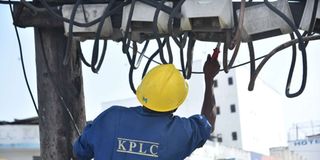
Kenya Power's electricity sales grew by 8.5 per cent in January to a record 956.76 million kilowatt-hours.
Kenya Power's electricity sales grew by 8.5 per cent in January to a record 956.76 million kilowatt-hours (kWh), pointing to enhanced economic activity.
This means that Kenya Power has sold over 900kWh of electricity for six consecutive months except December 2024 when consumers took up 882.09 million KWh of power, according to data from the Kenya National Bureau of Statistics (KNBS).

A Kenya Power employee carries out repairs on Haile Selassie Road, Mombasa.
The first time Kenya Power posted sales above 900 million kWh in a single month was in July last year at 901.78 million kWh, and this trend has since been sustained except for December.
Sustained monthly electricity sales above 900 million kWh point to the rising pace of economic activities in the manufacturing and large businesses and offer a boost to Kenya Power’s revenues.
Commercial and industrial consumers account for the largest share of electricity sales at about 55 per cent, according to data from the Energy and Petroleum Regulatory Authority.
Increased demand
Local generators including Kenya Electricity Generating Company have been stepping up generation to match the increased demand, taking the January generation to 1,085.14 million kWh. February last year was the last time generation was below 1,000 million kWh.
The trend of rising sales looks set to continue, with Kenya Power data showing that peak demand hit 2,316 megawatts (MW) on February 12 this year— the highest ever recorded in Kenya’s history. This overtook the earlier peak of 2,036 MW that was posted in November last year.
Peak demand represents the highest load on the electricity grid over the year, typically occurring between 7:30 p.m. and 8.30 p.m. nationwide.
The country’s peak demand has been growing in the last five consecutive years, hitting 2,177 MW in the year ended June 2024 from 2,149 MW a year earlier. Peak demand stood at 1,926 MW five years ago.
Kenya Power's annual electricity sales crossed 10,000 gigawatt hours (GWh) in 2023 and closed the year ended June 2024 at 10,516 GWh. The power distributor projects that in the next four years, peak demand for electricity will surpass 2,800 MW.
The race by Kenya Power to hook up more consumers to the grid has led to increased consumption amid outcry over the cost and reliability of the supply.

Energy and Petroleum Regulatory Authority (EPRA) boss Daniel Kiptoo.
Increased demand has cut the country’s reserve margin—the level of unused available capacity of an electric power system— to four per cent, making the grid more vulnerable to power outages.
Industrial consumers
The firm says Kenya’s installed capacity currently stands at 3,243 MW, with an effective interconnected capacity of 3,056 MW on the grid.
Epra report released this week showed industrial consumers including large and medium industries, factories, high-rise buildings, warehouses and public infrastructure such as airports, ports, and railway stations saw a 3.73 percent rise in consumption to 2,807.10 GWh, accounting for 51.18 percent of the country’s total consumption.
“This is a 101.0GWh increase in consumption compared to 2,706.10GWh of electrical energy consumed in a similar period last year, signalling an increase in industrial activities,” said Epra.










